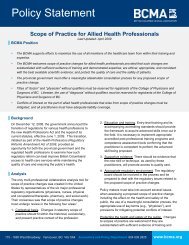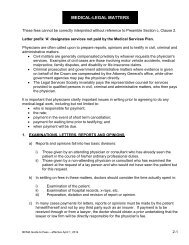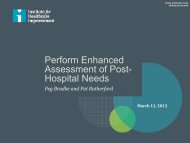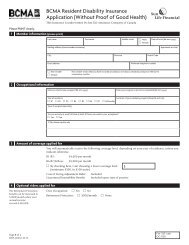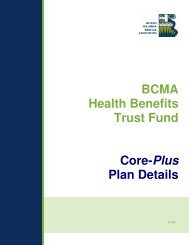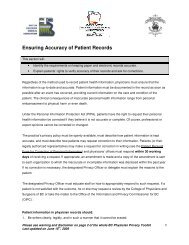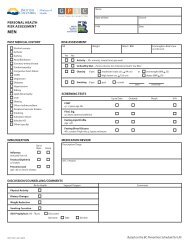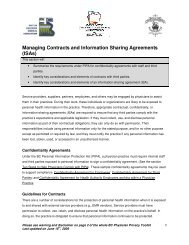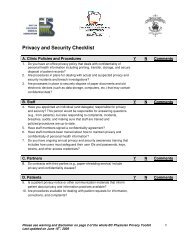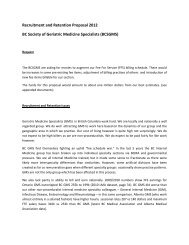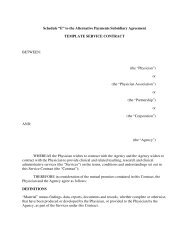Doctors Today and Tomorrow - British Columbia Medical Association
Doctors Today and Tomorrow - British Columbia Medical Association
Doctors Today and Tomorrow - British Columbia Medical Association
Create successful ePaper yourself
Turn your PDF publications into a flip-book with our unique Google optimized e-Paper software.
Forecasting Physician Supply<br />
Forecasting how many physicians will be required in the future is fundamental to overall workforce planning. Three<br />
different approaches have been used in Canada to model physician supply <strong>and</strong> dem<strong>and</strong>: supply forecasting, utilization<br />
forecasting, <strong>and</strong> needs-based planning. Each approach has advantages <strong>and</strong> disadvantages, which are considered<br />
below <strong>and</strong> summarized in Figure 2.<br />
Supply forecasting, or stock <strong>and</strong> flow analysis, is the most common approach for forecasting physician supply (Chan,<br />
2003). In this method, data on the current number (i.e., stock) of physicians are collected. Based on this initial starting<br />
point, numbers of additional personnel are generated, taking into account physician increases (i.e., new medical<br />
graduates <strong>and</strong> residents, immigration), decreases (i.e., deaths, retirements, emigration), <strong>and</strong> projected population<br />
growth. Using the physician-to-population ratio as the planning tool, scenario analyses can then be performed to<br />
examine the potential impact of changes in certain variables (e.g., what happens if the rate of retirement increases).<br />
Note, however, that the usefulness of supply forecasting is limited because the projections are based on the<br />
assumption that the physician-to-population ratio must either stay the same or be higher in the future to meet<br />
population health care needs. As well, the projections do not account for external factors that can affect the dem<strong>and</strong><br />
for physician services such as population demographics or disease prevalence. One widely-used supply forecasting<br />
model is the Canadian <strong>Medical</strong> <strong>Association</strong>’s Physician Resource Evaluation Template model (Buske, 2010d).<br />
Utilization forecasting is similar to supply forecasting, but it also takes into account the patterns of service delivery<br />
<strong>and</strong> utilization of health services (Task Force Two, 2005). In this analysis, current physician supply is estimated using per<br />
capito ratios in head counts or FTEs. These ratios are projected into the future, based on changes of physician flow rates<br />
<strong>and</strong> population growth. Adjustments for changing demographics may be performed by examining utilization rates<br />
in different patient age-sex categories <strong>and</strong> then modeling increases based on projected population growth in these<br />
categories.<br />
However, utilization measures are limited because they do not indicate whether physician supply is appropriate relative<br />
to the needs of the population, <strong>and</strong> they assume the level, mix <strong>and</strong> distribution of physicians remains constant over<br />
time.<br />
Needs-based planning estimates the health needs in the population by using disease prevalence or other healthrelated<br />
indicators (Task Force Two, 2005). This approach begins with the premise that the current distribution of<br />
physicians may not necessarily reflect the distribution of health care needs in the population. Although there is a<br />
growing consensus among decision-makers that planning for physician resources should be based on the population’s<br />
health care needs, few attempts have been made to translate these needs into physician resource requirements<br />
because of a limited knowledge base <strong>and</strong> methodological challenges (Canadian Nurses <strong>Association</strong> & Canadian<br />
<strong>Medical</strong> <strong>Association</strong>, 2007). One recent example is the development of a population needs-based physician simulation<br />
model in Ontario, which compares needs to the supply of physician services by using number of hours of care needed<br />
<strong>and</strong> provided, quantifying the variance, <strong>and</strong> converting the variance into a head count by applying the average number<br />
of hours worked per year (Ontario Ministry of Health <strong>and</strong> Long-Term Care <strong>and</strong> Ontario <strong>Medical</strong> <strong>Association</strong>, 2010).<br />
Some drawbacks of needs-based planning are the limited available data, lack of a “gold st<strong>and</strong>ard” method for<br />
translating need into physician requirements, <strong>and</strong> difficulty of prioritizing the population’s health needs, which can be<br />
an intricate <strong>and</strong> value-driven exercise.<br />
<strong>Doctors</strong> <strong>Today</strong> <strong>and</strong> <strong>Tomorrow</strong> – The Physician Workforce: Planning for the future 7



